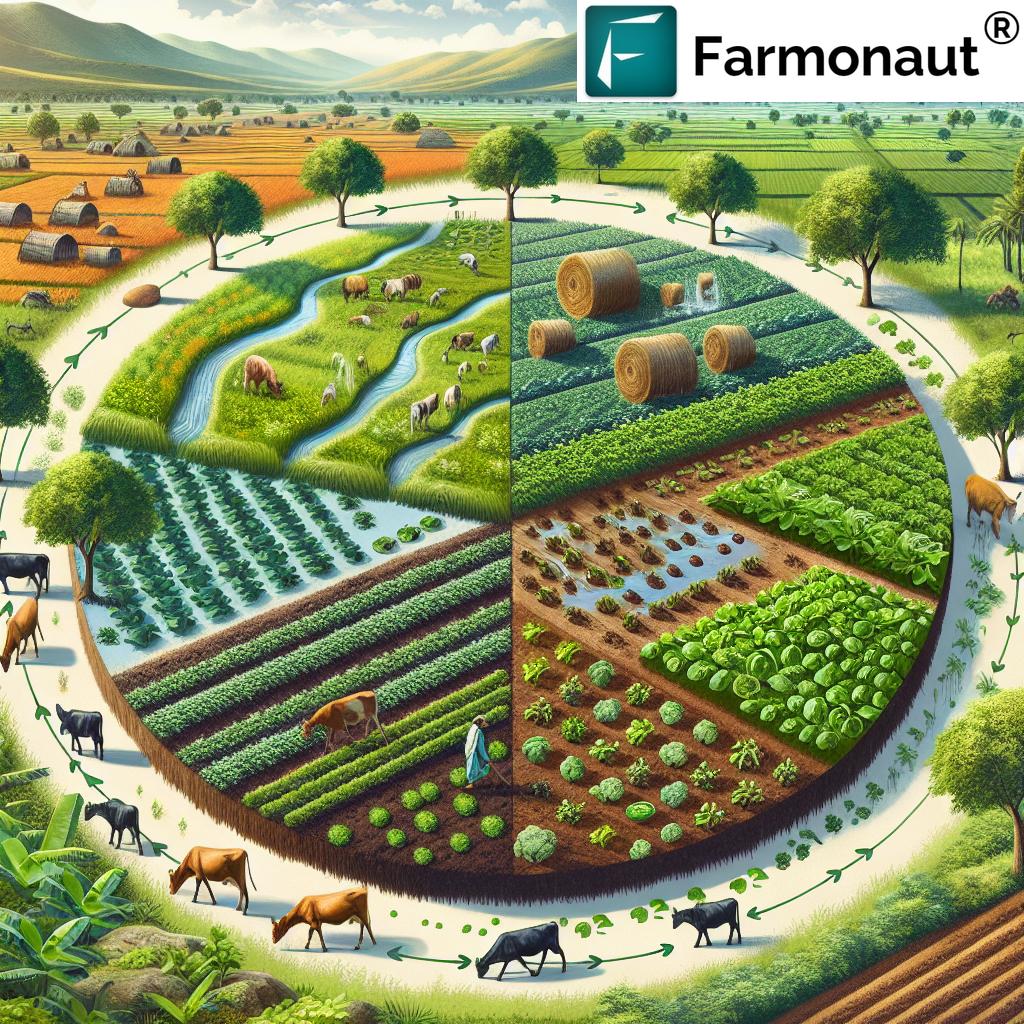Sustainable Farming Secrets: 7 India Methods Exposed!
“India’s zero-budget natural farming can reduce water usage by up to 50% compared to conventional methods.”
Introduction: Sustainable Agriculture in India
As we face mounting environmental concerns and increasing demand for food production, adopting sustainable farming practices is no longer a choice—it’s a necessity. Sustainable agriculture refers to methods that protect the environment, promote soil health, conserve water, and foster biodiversity—all while ensuring economic viability and social responsibility. Our mission is to explore the core principles and innovative methods fueling India’s transformation towards resilient, eco-friendly agricultural systems.
In this definitive guide, we’ll expose the 7 most effective sustainable farming secrets in India—including crop rotation, cover cropping, water conservation in agriculture, agroforestry systems, and more. Each method is carefully explained, highlighting its impact on soil health in farming, resource savings, reducing chemical inputs in agriculture, and community resilience. We integrate technology-based solutions such as those offered by Farmonaut to empower farmers across the country.
Core Principles of Sustainable Farming
At the heart of sustainable agriculture in India (and globally) are three main principles:
- Environmental Stewardship: We aim to preserve natural resources by minimizing pollution, conserving water, reducing soil erosion, and promoting biodiversity.
- Economic Viability: Sustainable farming ensures profitable operations for farmers, with fair wages and strong support for local economies.
- Social Responsibility: This approach requires treating workers fairly, engaging with communities, and responsibly considering the impacts of farming practices.
These principles guide every sustainable decision we make, from choosing organic farming methods over chemical fertilizers to supporting policies that drive market adoption of sustainably produced products.
“Crop rotation in India increases soil organic carbon by 20%, enhancing long-term soil fertility and sustainability.”
Comparative Table: 7 Key Sustainable Farming Practices in India
Let’s compare India’s leading methods for sustainable agriculture, focusing on soil health in farming, water conservation, positive biodiversity impacts, and regional applicability:
| Method Name | Description | Estimated Water Savings (%) | Estimated Soil Health Improvement (%) | Impact on Biodiversity | Geographic Suitability (India) | Example Crops |
|---|---|---|---|---|---|---|
| Crop Rotation and Diversity | Alternating different crops (e.g., legumes & cereals) over seasons or years | 10–30% | Up to 20% | High | All-India, esp. Punjab, Haryana, Karnataka | Wheat, Rice, Pulses, Mustard |
| Cover Cropping | Planting cover crops (clover, rye) in off-seasons to boost soil fertility | Up to 25% | 15-25% | Medium-High | Madhya Pradesh, Odisha, Chhattisgarh | Maize, Lentil, Barley |
| No-Till or Reduced Tillage | Minimizing soil disturbance for improved soil structure & carbon sequestration | 20–30% | 20–30% | Medium | North India, Indo-Gangetic Plains | Wheat, Maize, Cotton |
| Integrated Pest Management (IPM) | Combining natural, physical, and limited chemical controls for pests | 5–15% | 10–18% | High | Andhra Pradesh, Tamil Nadu, Uttar Pradesh | Brinjal, Tomato, Sugarcane |
| Agroforestry | Integrating trees/shrubs into farmland for ecosystem & economic benefits | 15–40% | 15–35% | High | Kerala, West Bengal, NE States | Tea, Coffee, Fruits |
| Water Conservation | Drip irrigation, rainwater harvesting, and moisture management | 25–60% | 15–20% | Medium | Rajasthan, Gujarat, Maharashtra | Cotton, Grapes, Groundnut |
| Livestock Integration | Combining livestock with cropping for nutrient cycling & productivity | 10–20% | 10-25% | Medium-High | All-India (esp. Bihar, Uttar Pradesh) | Rice, Wheat, Maize (with Cattle, Goats) |
Explore farm insights with Farmonaut’s App:
-
Web App:

Get satellite-based farm monitoring, soil health mapping, and real-time crop insights for your fields! -
Android App:

-
iOS App:

-
API for Developers:
Farmonaut Satellite & Weather Data API
Documentation:
API Developer Docs
1. Crop Rotation and Diversity: The Foundation of Soil Health in Farming
Crop rotation is a centuries-old method trusted by farmers across India for preserving soil health and reducing chemical inputs in agriculture. By planting a variety of crops across different seasons or years, we break pest and disease cycles, minimize erosion, and naturally replenish depleted nutrients. For example, alternating cereals like wheat and rice with legumes such as chickpeas or lentils increases soil organic carbon and nitrogen, resulting in more fertile, resilient lands.
- Crop rotation benefits: Improved soil fertility, increased yields, less reliance on chemical fertilizers, better water management.
- Environmental impact: Promotes biodiversity, supports ecosystem health, and reduces the spread of pests and weeds.
- Regional practice: Popular in Punjab, Haryana, Karnataka, and parts of central India.
Did you know? According to research, diverse crop rotation can increase soil organic carbon by up to 20%—a key indicator of long-term sustainable farming.
2. Cover Cropping: Building Resilience Through Green Covers
Cover cropping involves growing cover crops such as clover, rye, or legumes during the off-season or between cash crops. These plants protect the soil surface, reduce erosion, and enhance fertility by adding organic matter. The roots of cover crops hold the soil together, while their decaying plant matter feeds the microbial life crucial for soil health in farming.
- Water conservation in agriculture: Reduces runoff and helps the soil retain moisture, saving up to 25% water usage in some systems.
- Weed suppression: Outcompetes and shades out weeds, reducing the need for synthetic herbicides.
- Soil improvement: Year-on-year cover cropping leads to better soil structure and increased nutrient cycling.
*Implementation tip*: After harvesting a main crop, sow ryegrass or clover mixed with local legumes for optimal off-season soil cover and enrichment.
3. No-Till or Reduced Tillage: Preserving the Living Soil Web
No-till and reduced tillage methods are gaining popularity among Indian agricultural communities, especially in North India’s rich plains. This approach minimizes disturbance to the soil structure, leaving crop residues on the field, which guards against erosion, locks in moisture, and fosters carbon sequestration. These regenerative farming techniques allow beneficial organisms, such as earthworms and fungi, to thrive naturally.
- Water savings: By not turning the soil, up to 30% less water is required due to reduced evaporation.
- Soil health boost: Less disruption leads to stronger soil biodiversity and higher organic matter content.
- Reduced inputs: Less fuel, labor, and costly fertilizers are needed as natural soil processes are enhanced.
*Regional insight*: No-till is ideal for wheat, maize, and cotton fields in Punjab, Haryana, and Indo-Gangetic plains.
4. Integrated Pest Management (IPM): Balancing Nature and Productivity
Integrated Pest Management (IPM) is a holistic pest-control method that relies on understanding pest life cycles, crop-ecosystem interactions, and the use of biological, physical, and selective chemical controls. In Indian farming, IPM enables us to reduce dependence on chemical pesticides while promoting cultural and natural pest controls.
- How it works: Use of natural predators (like ladybugs and parasitoid wasps), pest-resistant crop varieties, pheromone traps, and minimal pesticides only as a last resort.
- Benefits: IPM reduces chemical pollution, protects farmer and consumer health, maintains ecosystem balance, and increases yields.
- Examples: Sugarcane in Tamil Nadu, brinjal and tomato fields in Andhra Pradesh, and rice in Uttar Pradesh.
For advanced pest detection and advisory, Farmonaut’s AI-powered Jeevn system leverages real-time satellite data, helping farmers act before pest outbreaks reduce yields.
5. Agroforestry Systems: Merging Trees and Cropland for Mutual Growth
Agroforestry systems integrate trees, shrubs, or even forest crops into traditional farms. In India’s unique environments—from Kerala’s plantations to the tea gardens of Assam and hilly Northeast regions—agroforestry strengthens soil health, resists wind and water erosion, and creates new income streams for farmers via timber, fruits, or nuts.
- Biodiversity impact: Adding trees increases on-farm biodiversity and provides shade, microclimate regulation, and wildlife habitat.
- Resilience: Trees buffer crops against droughts, floods, and storms—an increasingly relevant adaptation for climate change.
- Carbon benefits: Agroforestry is a powerful tool for carbon sequestration, naturally removing carbon from the atmosphere and storing it in plant biomass and soils.
Farmonaut’s satellite & AI solutions enable farmers and plantation owners to map tree cover, count trees, and optimize agroforestry layouts for maximum environmental and economic benefit. Explore Agro Admin App for plantation & forest advisory here.
6. Water Conservation in Agriculture: Securing India’s Future
Water is a critical constraint for much of Indian agriculture. We must conserve water resources to ensure productive, resilient farms now and in the coming decades. Techniques such as drip irrigation, rainwater harvesting, and rigorous soil moisture management can collectively reduce water consumption by 25-60% compared to traditional flood irrigation.
- Drip irrigation: Provides water directly to plant roots, minimizing evaporation losses. Especially beneficial for cash crops like grapes, cotton, and groundnut in dry regions (e.g., Maharashtra, Gujarat, Rajasthan).
- Rainwater harvesting: Traps seasonal rainfall for use during dry months, reducing dependence on depleting groundwater sources.
- Mulching and micro-basin techniques: Organic mulches retain moisture, lower soil temperature, and prevent compaction after heavy rains.
For farm-scale water tracking and moisture mapping, Farmonaut’s real-time NDVI and soil moisture analytics support smarter irrigation decisions, saving both water and costs.
Want to lower your environmental footprint? Farmonaut Carbon Footprinting helps farms measure and reduce greenhouse gas emissions—a critical aspect of sustainable resource management.
7. Livestock Integration: Closing the Loop for True Farm Sustainability
Integrating crops and livestock creates a circular system, where animal manure fertilizes crops and crop residues feed livestock. This technique, practiced for generations in Indian villages, reduces dependence on chemical fertilizers and establishes a reliable on-farm nutrient cycle.
- Organic nutrient boost: Cow dung and compost replace synthetic fertilizers with natural, slow-release nutrients, improving soil structure and moisture retention.
- Inputs cost reduction: Farm by-products (e.g., rice straw, maize stalks) are efficiently converted to animal feed, reducing waste and increasing overall farm profitability.
- Resilience to market shocks: Integrated farms can buffer losses from crop or livestock market price fluctuations by having diversified income sources.
*Best practice*: Rotate grazing areas, compost animal manure thoroughly, and select mixed cropping-livestock systems appropriate to your region.
Leverage Technology for Sustainable Agriculture: Farmonaut’s Role
We firmly believe precision agriculture technology is the backbone of the next green revolution in India. With tools like Farmonaut, farmers across the country can now access advanced data and actionable insights, no matter their location or farm size.
- Satellite-Based Crop Health Monitoring: Farmonaut’s multispectral imaging monitors vegetation stress, detects soil moisture deficits, and supports site-specific fertilizer application for maximized yield with minimal inputs.
- AI-Powered Jeevn Advisory: Personalized, real-time guidance for crop management, pest detection, and weather forecasting, helping farmers make informed decisions.
- Blockchain-Enabled Product Traceability: Farmonaut’s traceability platform helps agricultural corporates and food companies ensure supply chain transparency for consumer trust and compliance. More on Farmonaut Traceability.
- Fleet and Resource Management: Streamline your farm’s transport and machinery usage, cut operational costs, and improve safety. Learn about Fleet Management.
- Financial Access: Gain satellite-based verification for crop loans and insurance. Reduce fraud and accelerate fund disbursement. See Crop Loan & Insurance Tools.
Key Benefits of Sustainable Farming Practices in India
Environmental Benefits
- Reduce pollution: Less use of pesticides and fertilizers means cleaner groundwater and less runoff.
- Promote biodiversity: Mixed cropping, agroforestry, and IPM rebuild biological diversity lost to monocultures.
- Prevent erosion: Cover crops and no-till protect against soil loss, while organic matter boosts moisture retention.
- Increase carbon sequestration: More plant cover and trees draw down atmospheric carbon, fighting climate change.
Economic Benefits
- Reduce input costs: Lower fertilizer, pesticide, and irrigation bills. Farm profitability rises when resource use falls.
- Improve market resilience: Diversified farms weather price and climate shocks better than specialized, high-input systems.
- Stable employment: Sustainable agriculture invests in rural communities and supports livelihoods year-round.
Social & Community Benefits
- Food security: Local, reliable production reduces dependence on distant markets and improves household nutrition.
- Preserve traditions: Encourages the revival of traditional farming knowledge suited to local agro-climatic zones.
- Promote equity: Increased participation of women and marginalized groups through community-driven initiatives.
Challenges in Implementing Sustainable Agriculture in India
- Knowledge & Training: Farmers often need training and guidance to adopt new methods—education programs are crucial for successful transitions.
- Initial Investment: Drip irrigation, quality seeds for cover cropping, and tools for organic production may require upfront funds.
- Policy and Market Support: Current policies may still favor conventional agriculture; greater market demand and supportive government frameworks are essential for scaling up sustainable practices.
- Access to Credit and Insurance: Affordable credit, insurance, and digital infrastructure solutions like Farmonaut Crop Loan & Insurance are vital to encourage early adoption.
Long-term success means engaging all stakeholders—from government and NGOs to private companies and farmers themselves.
Global Examples: Sustainable & Regenerative Farming Techniques
- System of Rice Intensification (SRI): Widely adopted in India, SRI uses fewer seedlings, less water, and organic inputs for higher rice yields.
- Regenerative Cattle Farming: In the US, farmers rotate cattle through small paddocks to mimic wild herds—regenerating soil and storing more carbon, while enhancing biodiversity.
- Natural Farming in India: Practices like “zero-budget natural farming” harness cow dung, urine, and jaggery to nurture resilient, organic fields capable of weathering climate extremes.
Farmonaut’s technology is tailored to support both traditional and global best practices in sustainable agriculture, providing real-time data and resource management tools for any system.
Frequently Asked Questions (FAQ) on Sustainable Agriculture
What is sustainable farming?
Sustainable farming is an approach to food production that balances the needs of the environment, profitability, and equity. It protects soil health, conserves water, promotes biodiversity, and uses resources efficiently for long-term resilience.
How does crop rotation benefit Indian farmers?
Crop rotation breaks pest cycles, reduces the need for chemical pesticides and fertilizers, and increases soil fertility—boosting both yields and sustainability.
Can adopting sustainable practices reduce costs?
Yes! By minimizing chemical inputs, water, and fuel, and recycling nutrients, sustainable agriculture can improve farm profitability even as it protects natural resources.
How does technology like Farmonaut help?
Farmonaut provides real-time satellite-based crop health monitoring, AI-powered advisories, and blockchain traceability to make sustainable and precision farming accessible and affordable to all Indian farmers.
Why is water conservation critical in Indian agriculture?
With growing water scarcity, conserving water via drip irrigation, rainwater harvesting, and moisture management is key to maintaining farm productivity and ecosystem stability.
How can I start with sustainable farming on my field?
Begin with small steps: rotate crops, use organic matter, implement cover crops, conserve water, and use technology for monitoring. Seek local training and leverage platforms like Farmonaut for data-driven decisions.
Conclusion: The Future of Sustainable Farming in India
The future of Indian agriculture lies in embracing sustainable farming practices that protect the land, conserve water, and support thriving rural communities, all while securing high crop yields and economic stability. Sustainable agriculture—rooted in traditional knowledge, enhanced by modern technology like Farmonaut, and supported by transparent supply chains—will be the cornerstone of food security and climate resilience for decades to come.
Let’s work together to regenerate our soils, safeguard our water, and create biodiverse, prosperous landscapes—one field, one farmer, and one community at a time.
Ready to revolutionize your farm? Experience the benefits of satellite-based monitoring, AI advisory, and resource management with Farmonaut’s mobile and web app today!
Your journey to a more sustainable, resilient, and profitable farm starts now.















